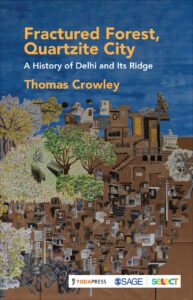Interviewed by Aarathi Ganesan; Edited by Nidhi Rejithlal.
New Delhi’s Ridge has born the brunt of mining, construction, and human encroachments for years. The result: ecologically degraded landscapes.
Now, how do we solve this problem? If human activities are the source of the Ridge’s problems, to “Save The Ridge” do we simply prevent humans from accessing it?
However, this may not be a desirable conservation solution either. After all, the Ridge lies at the centre of Delhi’s development as a city–how can it be justifiably separated from the working-class residents who depend on its resources?
In the second part of our interview series with Thomas Crowley, we explore how environmental activism that focuses on ecology alone can be harmful. Drawing on his latest work “Fractured Forest, Quartzite City” published by SAGE and Yoda Press, Crowley examines how and why “removing humans” from the conservation picture isn’t a sustainable solution to ecological issues. In the process, Crowley reinforces the need for an environmentalism that not only secures environmental justice for ecologies, but social justice for the people who depend on them too.






